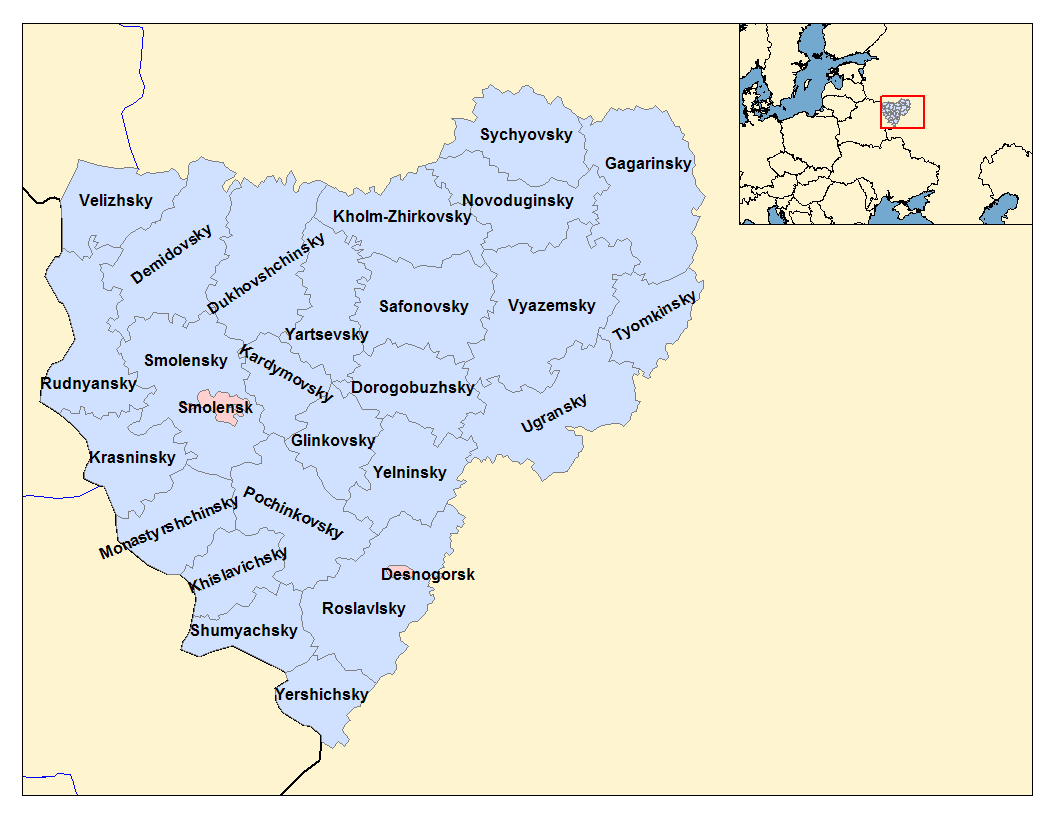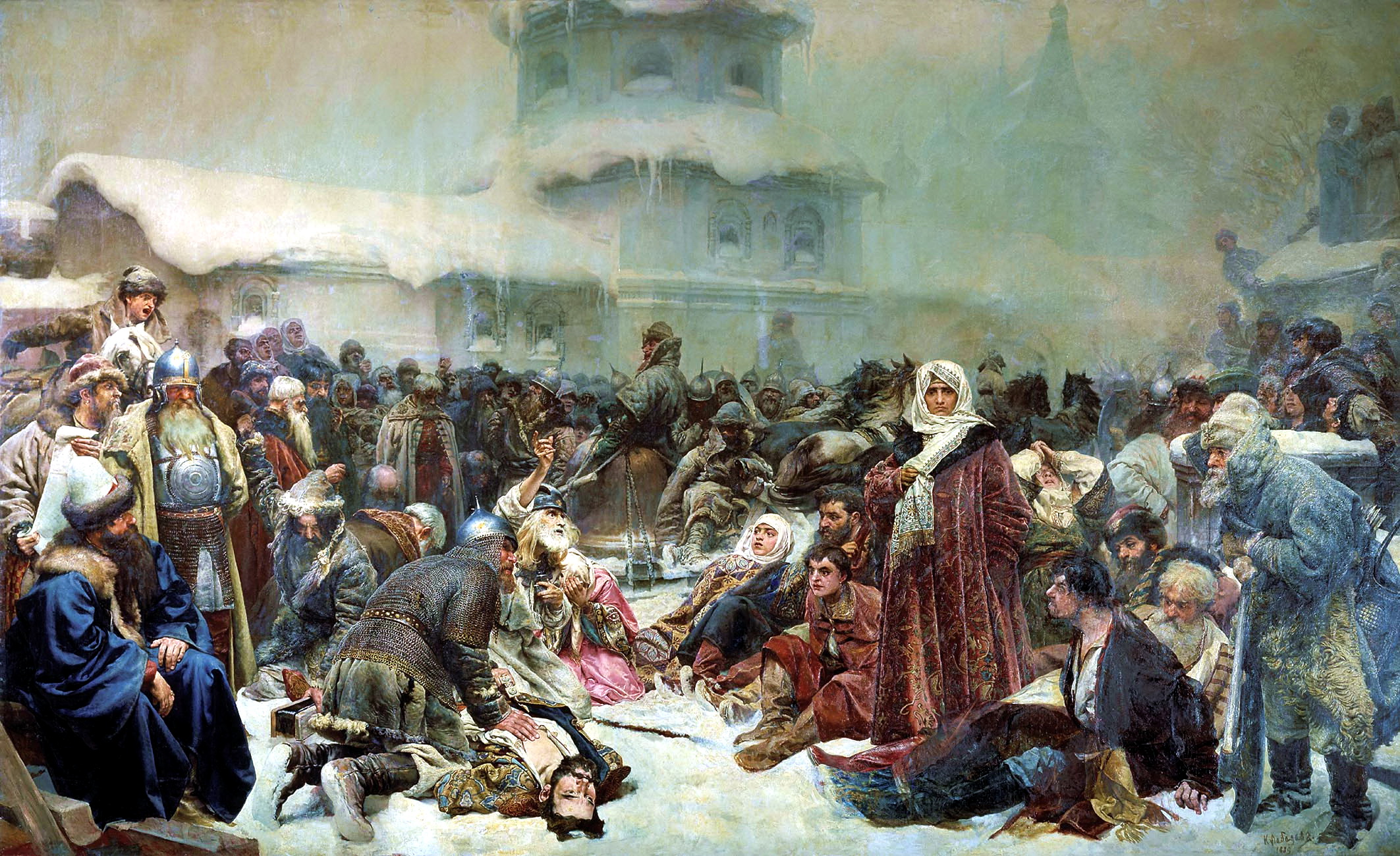|
Sychyovka, Sychyovsky District, Smolensk Oblast
Sychyovka (russian: Сычёвка) is a town and the administrative center of Sychyovsky District in Smolensk Oblast, Russia, located between the Vazuza and Losmina Rivers, northeast of Smolensk, the administrative center of the oblast. Population: Etymology The name of the town derives from the Russian word "" (''sych''), which literally means "little owl", but can also mean "a gloomy person". History It was first mentioned in 1488 as a votchina of a Tver prince Ivan the Young, son of Ivan III. In 1493, it became a palace village in Vyazminsky Uyezd. In 1776, Sychyovka was granted town status. During World War II, the town was occupied by the German Army from October 10, 1941 until March 8, 1943, when it was liberated by troops of the Soviet Western Front. On January 7, 1943, Jews of the town were murdered in a mass execution perpetrated by an Einsatzgruppen. Administrative and municipal status Within the framework of administrative divisions, Sychyo ... [...More Info...] [...Related Items...] OR: [Wikipedia] [Google] [Baidu] |
Smolensk Oblast
Smolensk Oblast (russian: Смоле́нская о́бласть, ''Smolenskaya oblast''; informal name — ''Smolenschina'' (russian: Смоле́нщина)) is a federal subject of Russia (an oblast). Its administrative centre is the city of Smolensk. As of the 2010 Census, its population was 985,537. Geography The oblast was founded on 27 September 1937.Исполнительный комитет Смоленского областного совета народных депутатов. Государственный архив Смоленской области. "Административно-территориальное устройство Смоленской области. Справочник", изд. "Московский рабочий", Москва 1981. Стр. 8 It borders Pskov Oblast in the north, Tver Oblast in the northeast, Moscow Oblast in the east, Kaluga Oblast in south, Bryansk Oblast in the southwest, and Mogilev and Vitebsk ... [...More Info...] [...Related Items...] OR: [Wikipedia] [Google] [Baidu] |
Ivan III Of Russia
Ivan III Vasilyevich (russian: Иван III Васильевич; 22 January 1440 – 27 October 1505), also known as Ivan the Great, was a Grand Prince of Moscow and Grand Prince of all Rus'. Ivan served as the co-ruler and regent for his blind father Vasily II from the mid-1450s before he officially ascended the throne in 1462. He multiplied the territory of his state through war and through the seizure of lands from his dynastic relatives, ended the dominance of the Tatars over Russia, renovated the Moscow Kremlin, introduced a new legal codex and laid the foundations of the Russian state. His 1480 victory over the Great Horde is cited as the restoration of Russian independence, 240 years after the fall of Kiev in the Mongol invasion of Kievan Rus'. Ivan was the first Russian ruler to style himself " tsar", albeit not as an official title. Through marriage to Sofia Paleologue, he made the double-headed eagle Russia's coat of arms and adopted the idea of Moscow as ... [...More Info...] [...Related Items...] OR: [Wikipedia] [Google] [Baidu] |
Cities And Towns In Smolensk Oblast
A city is a human settlement of notable size.Goodall, B. (1987) ''The Penguin Dictionary of Human Geography''. London: Penguin.Kuper, A. and Kuper, J., eds (1996) ''The Social Science Encyclopedia''. 2nd edition. London: Routledge. It can be defined as a permanent and densely settled place with administratively defined boundaries whose members work primarily on non-agricultural tasks. Cities generally have extensive systems for housing, transportation, sanitation, utilities, land use, production of goods, and communication. Their density facilitates interaction between people, government organisations and businesses, sometimes benefiting different parties in the process, such as improving efficiency of goods and service distribution. Historically, city-dwellers have been a small proportion of humanity overall, but following two centuries of unprecedented and rapid urbanization, more than half of the world population now lives in cities, which has had profound consequ ... [...More Info...] [...Related Items...] OR: [Wikipedia] [Google] [Baidu] |
Subdivisions Of Russia
Russia is divided into several types and levels of subdivisions. Federal subjects Since 30 September 2022, the Russian Federation has consisted of eighty-nine federal subjects that are constituent members of the Federation.Constitution, Article 65 However, six of these federal subjects—the Republic of Crimea, the Donetsk People's Republic, the Kherson Oblast, the Lugansk People's Republic, the federal city of Sevastopol and the Zaporozhye Oblast—are internationally recognized as part of Ukraine. All federal subjects are of equal federal rights in the sense that they have equal representation—two delegates each—in the Federation Council (upper house of the Federal Assembly). They do, however, differ in the degree of autonomy they enjoy. De jure, there are 6 types of federal subjects—24 republics, 9 krais, 48 oblasts, 3 federal cities, 1 autonomous oblast, and 4 autonomous okrugs. Autonomous okrugs are the only ones ... [...More Info...] [...Related Items...] OR: [Wikipedia] [Google] [Baidu] |
Einsatzgruppen
(, ; also ' task forces') were (SS) paramilitary death squads of Nazi Germany that were responsible for mass murder, primarily by shooting, during World War II (1939–1945) in German-occupied Europe. The had an integral role in the implementation of the so-called "Final Solution to the Jewish question" () in territories conquered by Nazi Germany, and were involved in the murder of much of the intelligentsia and cultural elite of Poland, including members of the Catholic priesthood. Almost all of the people they murdered were civilians, beginning with the intelligentsia and swiftly progressing to Soviet political commissars, Jews, and Romani people, as well as actual or alleged partisans throughout Eastern Europe. Under the direction of Heinrich Himmler and the supervision of SS- Reinhard Heydrich, the operated in territories occupied by the Wehrmacht (German armed forces) following the invasion of Poland in September 1939 and the invasion of the Soviet Union in ... [...More Info...] [...Related Items...] OR: [Wikipedia] [Google] [Baidu] |
Western Front (Soviet Union)
The Western Front was a front of the Red Army, one of the Red Army Fronts during World War II. The Western Front was created on 22 June 1941 from the Western Special Military District (which before July 1940 was known as Belorussian Special Military District). The first Front Commander was Dmitry Pavlov (continuing from his position as District Commander since June 1940). The western boundary of the Front in June 1941 was long, from the southern border of Lithuania to the Pripyat River and the town of Włodawa. It connected with the adjacent North-Western Front, which extended from the Lithuanian border to the Baltic Sea, and the Southwestern Front in Ukraine. Operational history Front dispositions 22 June 1941 The 1939 partition of Poland according to the Molotov–Ribbentrop Pact established a new western border with no permanent defense installations, and the army deployment within the Front created weak flanks. At the outbreak of war with Germany, the Western Spe ... [...More Info...] [...Related Items...] OR: [Wikipedia] [Google] [Baidu] |
Red Army
The Workers' and Peasants' Red Army (Russian language, Russian: Рабо́че-крестья́нская Кра́сная армия),) often shortened to the Red Army, was the army and air force of the Russian Soviet Federative Socialist Republic and, after 1922, the Union of Soviet Socialist Republics. The army was established in January 1918. The Bolsheviks raised an army to oppose the military confederations (especially the various groups collectively known as the White Army) of their adversaries during the Russian Civil War. Starting in February 1946, the Red Army, along with the Soviet Navy, embodied the main component of the Soviet Armed Forces; taking the official name of "Soviet Army", until its dissolution in 1991. The Red Army provided the largest land warfare, land force in the Allied victory in the European theatre of World War II, and its Soviet invasion of Manchuria, invasion of Manchuria assisted the unconditional surrender of Empire of Japan, Imperial Japan. ... [...More Info...] [...Related Items...] OR: [Wikipedia] [Google] [Baidu] |
Rzhev Battles
The Battles of Rzhev (russian: Ржевская битва, Rzhevskaya bitva) were a series of Red Army offensives against the Wehrmacht between January 8, 1942, and March 31, 1943, on the Eastern Front of World War II. The battles took place in the northeast of Smolensk Oblast and the south of Tver Oblast. Due to the high losses suffered by the Soviet Army, the campaign became known by veterans and historians as the "Rzhev Meat Grinder" (russian: link=no, Ржевская мясорубка, Rzhevskaya myasorubka). Overview The major operations that were executed in this area of the front were: # #Rzhev–Vyazma strategic offensive operation (8 January – 20 April 1942) (russian: link=no, Ржевско-Вяземская стратегическая наступательная операция) of the Kalinin Front, Western Front, Bryansk Front, and Northwestern Front #*Sychyovka–Vyazma offensive operation (russian: link=no, Сычёвско-Вяземская наст ... [...More Info...] [...Related Items...] OR: [Wikipedia] [Google] [Baidu] |
Battle Of Moscow
The Battle of Moscow was a military campaign that consisted of two periods of strategically significant fighting on a sector of the Eastern Front (World War II), Eastern Front during World War II. It took place between September 1941 and January 1942. The Soviet defensive effort frustrated Adolf Hitler, Hitler's attack on Moscow, the capital and largest city of the Soviet Union. Moscow was one of the primary Strategic goal (military), military and political objectives for Axis forces in their Operation Barbarossa, invasion of the Soviet Union. The German Strategic Offensive, named Operation Typhoon, called for two Pincer movement, pincer offensives, one to the north of Moscow against the Kalinin Front by the 3rd Panzer Army, 3rd and 4th Panzer Army, 4th Panzer Armies, simultaneously severing the Saint Petersburg–Moscow Railway, Moscow–Leningrad railway, and another to the south of Moscow Oblast against the Western Front (Soviet Union), Western Front south of Tula, Russia, Tul ... [...More Info...] [...Related Items...] OR: [Wikipedia] [Google] [Baidu] |
Wehrmacht
The ''Wehrmacht'' (, ) were the unified armed forces of Nazi Germany from 1935 to 1945. It consisted of the ''Heer'' (army), the ''Kriegsmarine'' (navy) and the ''Luftwaffe'' (air force). The designation "''Wehrmacht''" replaced the previously used term and was the manifestation of the Nazi regime's efforts to rearm Germany to a greater extent than the Treaty of Versailles permitted. After the Nazi rise to power in 1933, one of Adolf Hitler's most overt and audacious moves was to establish the ''Wehrmacht'', a modern offensively-capable armed force, fulfilling the Nazi régime's long-term goals of regaining lost territory as well as gaining new territory and dominating its neighbours. This required the reinstatement of conscription and massive investment and defense spending on the arms industry. The ''Wehrmacht'' formed the heart of Germany's politico-military power. In the early part of the Second World War, the ''Wehrmacht'' employed combined arms tactics (close- ... [...More Info...] [...Related Items...] OR: [Wikipedia] [Google] [Baidu] |
World War II
World War II or the Second World War, often abbreviated as WWII or WW2, was a world war that lasted from 1939 to 1945. It involved the World War II by country, vast majority of the world's countries—including all of the great powers—forming two opposing military alliances: the Allies of World War II, Allies and the Axis powers. World War II was a total war that directly involved more than 100 million Military personnel, personnel from more than 30 countries. The major participants in the war threw their entire economic, industrial, and scientific capabilities behind the war effort, blurring the distinction between civilian and military resources. Air warfare of World War II, Aircraft played a major role in the conflict, enabling the strategic bombing of population centres and deploying the Atomic bombings of Hiroshima and Nagasaki, only two nuclear weapons ever used in war. World War II was by far the List of wars by death toll, deadliest conflict in hu ... [...More Info...] [...Related Items...] OR: [Wikipedia] [Google] [Baidu] |






